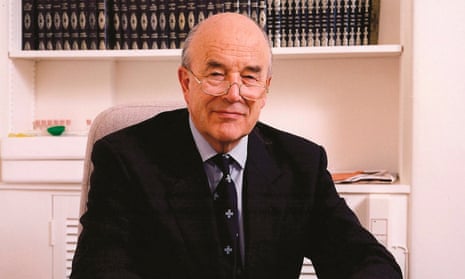Robin Ling, who has died aged 90, was an orthopaedic surgeon at the Princess Elizabeth Orthopaedic hospital in Exeter whose contribution to hip surgery resulted in an improved quality of life for millions of people. His research and teaching had a profound influence on the development of hip replacement operations and of revision (re-do) hip surgery. He was responsible for establishing many of today’s surgical techniques.
His research built on the work of Sir John Charnley, who pioneered the total hip replacement in the early 1960s. With Clive Lee, an engineer at Exeter University, Robin designed a tapered implant shape that he thought would help the stem remain firmly attached to the skeleton in the long-term. Their implant was first inserted in 1970 and is still used today, with some minor alterations. The “Exeter stem” has been shown to work well in patients of all ages, no matter the shape of their anatomy or the cause of their arthritic hip.
Robin’s observations of how the implant functioned in patients led to extensive laboratory studies in Exeter. Robin and Lee proved that bone cement, the polymer used to anchor an implant, can over time undergo “cold flow” and behave as a viscous liquid. This phenomenon (known as “creep”) is valuable in transmitting weight through the joint to the skeleton and allows patients to remain active for decades without pain. This explanation of how “taper-slip” cemented stems function has become part of mainstream orthopaedic teaching around the world.
The outstanding performance of the Exeter stem, designed by Robin, has led all the main manufacturers of artificial hips to market a copy. It is the most implanted cemented stem internationally and the most popular implant in the UK: more than 100,000 hip stems are now used each year. More than 1m operations had been undertaken by the end of 2010 and, such is the success of the implant, it is likely that by the 50th anniversary of its inception more than 2m stems will have been inserted.
Robin demonstrated that the quality of the surgery carried out would often define how long the hip survived in patients and he developed sophisticated cementing techniques that continue to be taught around the world. The success rate of the original stem for not loosening is more than 93% at 33 years; using the new cementing techniques, stems inserted today have even better results.
His contribution to revision surgery resulted from a close relationship with Professor Tom Slooff from Nijmegen in the Netherlands. They developed a technique for repairing the damage to surrounding bones that can result from the loosening of an implant. Although it has become established around the world, the technique is used less now, principally because of the excellent long-term results of the primary taper-slip stem, which rarely loosens.
Robin grew up in Keighley, which was then a wool town in the West Riding of Yorkshire, where his parents and grandfather were doctors. His grandfather, known as “old Dr Ling”, covered the more affluent part of town. His father, known as “Dr Billy”, treated the less wealthy part. His mother, Mona, ran the medical practice during the second world war. Robin was born in London, however, a precaution dictated by a breech birth and deplored by his father, who feared this might prevent his son from playing cricket for Yorkshire.
During the second world war Robin was sent to British Columbia, and afterwards he studied medicine at Magdalen College, Oxford, and St Mary’s hospital, London. After he passed his surgical fellowship, he returned to Canada as medical director of the emergency department at Vancouver General hospital but came back to the UK to complete his orthopaedic training in Edinburgh. His first consultant appointment was at Princess Margaret Rose hospital and the Royal Infirmary, Edinburgh, but he went to Devon for his definitive consultant post in Exeter in 1963. His intellect was recognised by Charnley himself, who came to Exeter to observe surgery.
Robin’s scientific work and teaching did not prevent him from contributing in all areas of professional life. He sat on numerous editorial boards, chaired regional and national committees, headed national and international professional bodies and was honorary professor of bioengineering in the school of engineering at Exeter University. He was appointed OBE in 1992.
He was generous with his time to all the surgeons from around the world who travelled to Exeter to benefit from his knowledge. His personal warmth and modesty were the stuff of legend.
Robin was supported throughout his life by his wife, Mary (nee Steedman), whom he met at St Mary’s hospital and married in 1955. She survives him, along with their two daughters and four grandchildren.

Comments (…)
Sign in or create your Guardian account to join the discussion